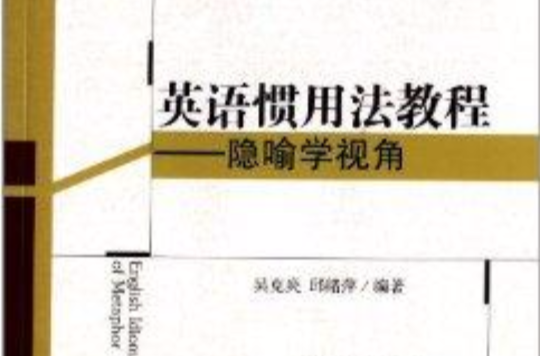本教材以認知理論為基礎,以隱喻學為視角解讀英語慣用法,通過大量實例讓學習者理解人類運用簡單熟悉的認知域解釋複雜抽象認知域的思維習慣,提高形象思維和類比思維能力,為提高思辨能力打好基礎。具體內容以人類最熟悉的喻體即人體器官開始編寫,由淺入深,逐步深入到食物、服裝、自然物質、顏色、動植物、文化等,符合人類認知從簡單到複雜的基本規律,配上文化溯源的解釋,有利於學習者有效習得。
基本介紹
- 書名:英語慣用法教程:隱喻學視角
- 作者:吳克炎 邱緒萍
- 出版日期:2014年4月1日
- 語種:簡體中文, 英語
- ISBN:7300188648
- 外文名:English Ldioms in the Perspective of Metaphor
- 出版社:中國人民大學出版社
- 頁數:232頁
- 開本:16
- 品牌:中國人民大學出版社
作者簡介,圖書目錄,文摘,
作者簡介
吳克炎,男, 1994年畢業於漳州師範學院,現任閩南師大外國語學院副教授、碩士生導師。曾在北京大學擔任訪問學者1年、在紐西蘭進修TKT。主要教授修辭學、英語慣用法、翻譯、寫作等課程,從事修辭學、翻譯理論與實踐研究。主持完成廳校級課題5項,在《中國大學教學》等學術刊物上發表論文30餘篇,翻譯出版漢英對照的《汝窯遺珍》、《漳州非物質文化遺產名錄》。2010年在北京理工大學出版社出版專著《跨文化交際視域下的修辭學》。
邱緒萍,女,2006年畢業於南開大學,獲英語語言文學碩士學位。主要從事翻譯理論與實踐研究,翻譯出版譯著《僱主品牌》、《創造性智慧型》、《Lonely Planet旅行指南系列英國》等五部,約100萬字。
邱緒萍,女,2006年畢業於南開大學,獲英語語言文學碩士學位。主要從事翻譯理論與實踐研究,翻譯出版譯著《僱主品牌》、《創造性智慧型》、《Lonely Planet旅行指南系列英國》等五部,約100萬字。
圖書目錄
Unit One General Outlook of English Idioms
Unit Two Some Basic Theories and Time Idioms
Unit Three Body Idioms (Ⅰ)
Unit Four Body Idioms (Ⅱ)
Unit Five Body Idioms (Ⅲ)
Unit Six Body Idioms (IV)
Unit Seven Body Idioms (Ⅴ)
Unit Eight Body Idioms (Ⅵ)
Unit Nine Food Idioms (Ⅰ)
Unit Ten Food Idioms (Ⅱ)
Unit Eleven Clothes Idioms (Ⅰ)
Unit Twelve Clothes Idioms (Ⅱ)
Unit Thirteen Idioms Concerning Spatial Relationship
Unit Fourteen Nature Idioms (Ⅰ)
Unit Fifteen Nature Idioms (Ⅱ)
Unit Sixteen Nature Idioms (Ⅲ)
Unit Seventeen Nature Idioms (Ⅳ)
Unit Eighteen Idioms on Social Culture
REFERENCES
Appendix Bilingual Presentation of Idioms
後記
Unit Two Some Basic Theories and Time Idioms
Unit Three Body Idioms (Ⅰ)
Unit Four Body Idioms (Ⅱ)
Unit Five Body Idioms (Ⅲ)
Unit Six Body Idioms (IV)
Unit Seven Body Idioms (Ⅴ)
Unit Eight Body Idioms (Ⅵ)
Unit Nine Food Idioms (Ⅰ)
Unit Ten Food Idioms (Ⅱ)
Unit Eleven Clothes Idioms (Ⅰ)
Unit Twelve Clothes Idioms (Ⅱ)
Unit Thirteen Idioms Concerning Spatial Relationship
Unit Fourteen Nature Idioms (Ⅰ)
Unit Fifteen Nature Idioms (Ⅱ)
Unit Sixteen Nature Idioms (Ⅲ)
Unit Seventeen Nature Idioms (Ⅳ)
Unit Eighteen Idioms on Social Culture
REFERENCES
Appendix Bilingual Presentation of Idioms
後記
文摘
In this unit, we come to Section Three and begin to learn idioms applying
words concerning human body as association vehicles.
Please read the following quotation:
原始人類總是用自身的一切去類比大千世界,即古人所謂“近取諸身”(《周易》)。義大利哲學家維柯(1986:180-181)指出:“值得注意的是在一切語種里大部分涉及無生命的事物的表達方式都是用人體及其各部分以及用人的感覺和情慾的隱喻來形成的……人在無知中就把他自己當作權衡世間一切事物的標準。
and the following examples:
the heart of a city/story,
the neck of a bottle/microphone,
the face/back of a building/a watch,
the eyes of a potato/problem,
the head of a river/nail/village/office/page/on a beer,
the legs of a chair,
the nose of a plane/car,
From the above examples we may see that people often use human body to
describe inanimate objects, ideas, and abstractions. In this way, they make the inanimate animate, the abstract vivid and concrete. Please read more examples:
the finger of a clock,
the arm of a derrick/chair/tree/record-player/coat,
the back of a chair,
the foot of a mountain/page/lamp/table.
Can you give some other examples?
words concerning human body as association vehicles.
Please read the following quotation:
原始人類總是用自身的一切去類比大千世界,即古人所謂“近取諸身”(《周易》)。義大利哲學家維柯(1986:180-181)指出:“值得注意的是在一切語種里大部分涉及無生命的事物的表達方式都是用人體及其各部分以及用人的感覺和情慾的隱喻來形成的……人在無知中就把他自己當作權衡世間一切事物的標準。
and the following examples:
the heart of a city/story,
the neck of a bottle/microphone,
the face/back of a building/a watch,
the eyes of a potato/problem,
the head of a river/nail/village/office/page/on a beer,
the legs of a chair,
the nose of a plane/car,
From the above examples we may see that people often use human body to
describe inanimate objects, ideas, and abstractions. In this way, they make the inanimate animate, the abstract vivid and concrete. Please read more examples:
the finger of a clock,
the arm of a derrick/chair/tree/record-player/coat,
the back of a chair,
the foot of a mountain/page/lamp/table.
Can you give some other examples?

